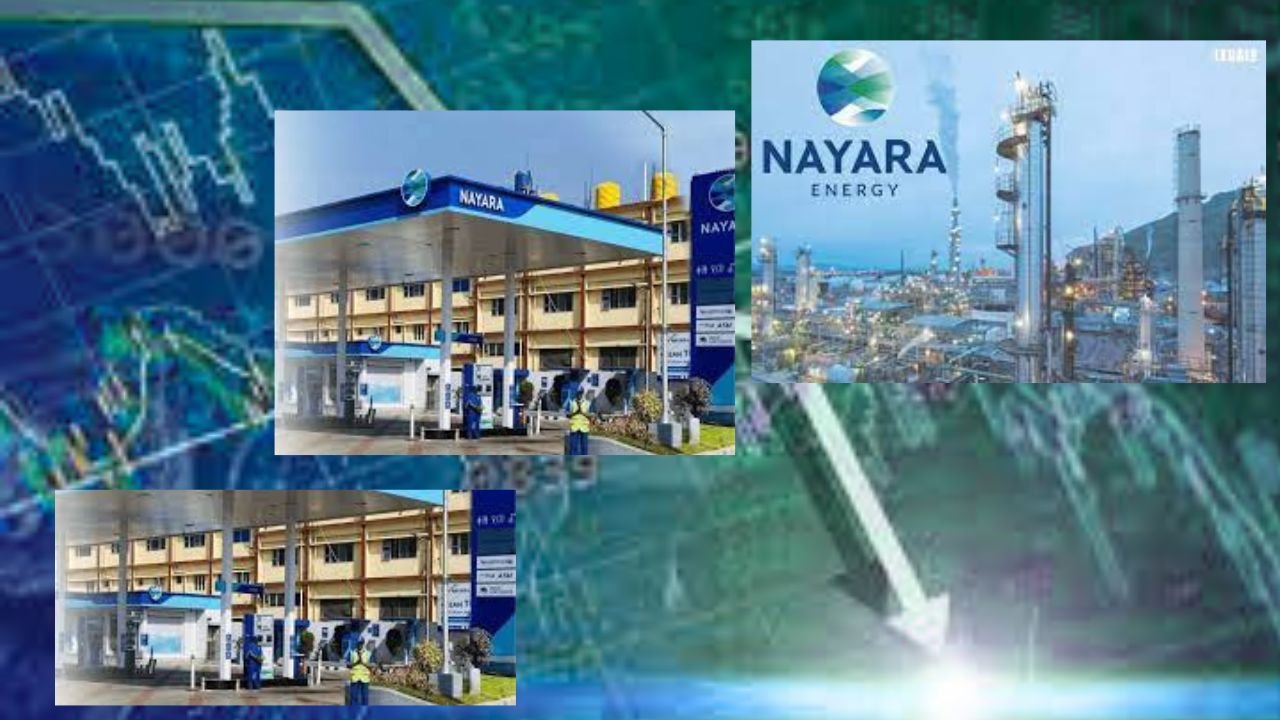The Sanction Squeeze: Inside Nayara Energy’s Desperate Scramble for a Lifeline from India
A geopolitical storm has descended upon Gujarat, compelling a Russian-connected behemoth to plead for vessels and payment routes, pushing the very boundaries of India's strategic autonomy.

Stand along the coast of Gujarat and gaze out at the vast industrial wonder that is the Vadinar refinery. It‘s a city of pipes and steel, a giant of the energy industry that can refine 400,000 barrels of oil each day. It has been a low-key, but mighty engine of the Indian economy for years, a symbol of industrial strength, refining crude oil from across the globe into the blood of a nation: its petrol, diesel, and jet fuel.
But now this physical giant is being disabled by an intangible foe.
A conflict being waged thousands of miles away in Ukraine has sent a financial ripple effect around the world, and it has just come ashore in India. Russia-associated Nayara Energy, which runs this giant refinery, is now under attack. Not by tanks or soldiers, but by something much more insidious and, in today’s world, perhaps even more potent: European Union sanctions.
Suddenly, the mundane, daily functions of operating a business have become insurmountable obstacles. Ships to transport the fuel are disappearing. Banks to handle payments are shutting their doors. A silent but devastating financial and logistical blockade has been placed around one of India‘s biggest private refiners.
The corporate crisis has now come to blow up into a national headache. In a desperation move, Nayara has gone to the Indian government for a lifeline. It is pleading for help in lining up ships. It is begging Indian banks to try, somehow, someway, to pay for its oil.
This is not a business tale anymore. This is a high-stakes geopolitics thriller unfolding in front of our eyes. This is the tale of a firm caught in the crosshairs of great power politics, and a nation, India, being put through a brutal trial of its much-touted “strategic autonomy.” What follows will not just shape the destiny of Nayara Energy but also pronounce loudly where India is in a new, fissiparous world order.
Section 1: The Anatomy of a Chokehold – How Sanctions Cripple a Giant
To begin understanding Nayara’s desperation, one has to understand the subtle nature of modern sanctions. They don’t blow things up; they unplug them from the global system. Nayara is getting pounded on two vital fronts.
Front #1: The Shipping Squeeze – The Ghost Fleet
The EU’s 18th package of sanctions did not deploy warships to blockade the Vadinar port. It did something much more powerful: it aimed at the enormous, interlinked network of sea logistics that enables international trade.
The Cancellations of Contracts: Shipping is an international industry dominated by a few giant players. When these giants—largely European—are informed that they cannot trade with a sanctioned party, they behave. For Nayara, it means that contracts that were years in the making to charter ships for transporting its refined petrol and diesel to Indian ports are being cancelled overnight.
The Blacklist of Insurance: This is the actual kill switch. A contemporary oil tanker is a multi-million-dollar vessel with a extremely combustible payload. It does not set sail from port without having strong insurance. The International Group of P&I Clubs, based in London, controls the global maritime insurance market and insures roughly 90% of the world’s ocean-borne tonnage. When EU sanctions strike, parties such as Nayara are in effect blacklisted. Without insurance, no serious ship owner will risk their ship. Nayara’s ships to charter have, practically speaking, become a ghost fleet—they are there, but they cannot be touched.
Hence the plea of Nayara to India’s Ministry of Ports, Shipping and Waterways. It is a plea to find a solution to an issue for which money cannot be a solution. It requires access to an alternative, sanction-proof shipping network.
Front #2: The Payment Blockade – When Money Isn’t Money
Simultaneously, the financial pipelines are being squeezed shut. A 400,000-barrel-per-day refinery consumes a staggering amount of crude oil, which must be paid for, usually in U.S. dollars, through the global banking system.
The Fear of Western Banks: Giant international banks, on which large dollar-denominated transactions must be processed, will not risk running afoul of EU or U.S. sanctions. The penalties are disastrous. They have simply ceased processing payments tied to Nayara, isolating the company from its usual financial conduits.
The Search for a Backchannel: This is why Nayara is now trying desperately to turn to Indian banks. The fact that UCO Bank is specifically mentioned is virtually like reading minds. UCO Bank has virtually no exposure to the Western financial system, which is exactly why it is so useful in this case. It had previously been instrumental in managing rupee-based trade with Iran when the country was under crippling sanctions. Nayara is looking to mirror this playbook: identify a bank that is sheltered from Western pressure and is able to establish a firewalled payment channel.
This two-prong squeeze—no vessels to transport the product and no simple means to pay for the raw materials—is a corporate stranglehold. It’s a deliberate strategy aimed at gradually starving the company of its operational throughput.
Section 2: The Domino Effect – The Grim Reality in the Control Room
The squeeze from this financial and supply-chain siege is no longer abstract. It‘s compelling hard–and-fast decisions in Vadinar’s control room.
The announcement that Nayara has begun to cut run rates at the refinery is the most tangible evidence of the crisis. A refinery is a process–run operation; you don’t slow it down lightly. It is a direct result of the bottlenecks.
Imagine this:
Suppose your storage tanks for refined fuel are full because you can’t get ships to remove it.
And if you are having trouble obtaining and paying for the next load of crude oil.
You have no other choice than to slow down the whole machine.
Reducing refinery runs is the factory version of a company putting itself into medically induced coma in order to preserve energy and stay alive. It’s a defensive action, but one that is extremely injurious. Every barrel that isn’t run is cash lost.
And yet, in a testament to its operational resilience (and likely its stockpiles), the company has so far managed to maintain stable fuel supplies within India. Furthermore, reports indicate it retained healthy liquidity in July, even as international buyers, spooked by the sanctions, pulled back.
This is creating a tight, cliff–hanging situation. Nayara is surviving now, but it is hemorrhaging. It is covering its day-to-day household liabilities, but its long-term sustainability is being jeopardized with every passing day. The pressure of operations is mounting, and without a lifeline, a breaking point is imminent.
Section 3: India’s High-Stakes Dilemma – A Test of Sovereignty
Nayara Energy’s plea for help has fallen squarely on the Indian government‘s lap, compelling it to meet a challenge that goes to the very heart of its foreign policy and economic security.
This is not just about one company anymore. This is India’s national interest at stake. Nayara controls 8-9% of India’s refining capacity and has a major retail presence. An extended outage has tangible implications for Indian consumers at the pump.
The government’s response is a high-wire, high-stakes tightrope act.
The Shipping Solution: Creating a Parallel Fleet
The attempt by the government to employ locally flagged ships is an enormously important development. It is an effort to create a domestic, sanction-immune system.
The Upside: It provides energy security to India. It maintains Nayara’s fuel supply chain to its outlets, keeping prices stable and shortages at bay. It is a strong statement of India’s “strategic autonomy”—its ability to put its own economic interests first rather than be guided by the foreign policy interests of the West.
The Downside: It’s a logistical headache. Does India possess locally registered tankers appropriate to the task? Do they access sovereign-backed insurance? This step would be interpreted in Brussels and Washington as India actively assisting a Russia-affiliated player in evading sanctions. It’s a step that would attract political tensions and even possible secondary sanctions in the future.
The Financial Solution: Leverage the Backchannel
Similarly, giving a green light to a bank like UCO to deal with Nayara’s transactions is a major political decision dressed up as a commercial one.
Upside: Solved the immediate payment crisis of Nayara. Complemented India-Russia economic relationship – the reason India could get cheap energy and defense supplies. Built India’s capacity to do business outside the Western-dominated financial system.
The Drawback: This is a clear, unequivocal questioning of the effectiveness of Western sanctions. It risks implicating the selected bank and telling the world that India is willing to offer a financial refuge for the targeted parties of its Western allies.
Either way, New Delhi is being compelled to make a choice. Does it yield to pressure from the West and allow a significant domestic refiner to atrophy at the expense of its own energy security? Or does it defend its national interest, exercising its sovereignty and inviting the ire of its strategic partners in the West?
Conclusion: A Microcosm of a New World Order
The Nayara Energy crisis is more than a headline. It is a moment of definition. It is an in-real-time stress test of the globalized system we thought we knew.
The sanction walls that were unseen in Brussels have become a quite tangible crisis in Gujarat. The reaction, being drawn up in New Delhi, will be a resounding declaration of intent. The choice to send Indian-flagged vessels and initiate sanction-proof banking systems would be a major step towards the development of alternative economic architecture, one that was less reliant on the West.
This is the 21st century’s great game, played not on a battlefield but in boardrooms, in ministries, and in the fine print of shipping insurance policies. Nayara Energy‘s fate will be the first chapter. But the tale it will tell will be one of India’s struggle, its ambition, and its final decision.
(Disclaimer: This article is for informational and educational purposes only. It does not constitute financial advice or a recommendation to buy or sell any securities. Please consult with a qualified financial advisor before making any investment decisions.)





